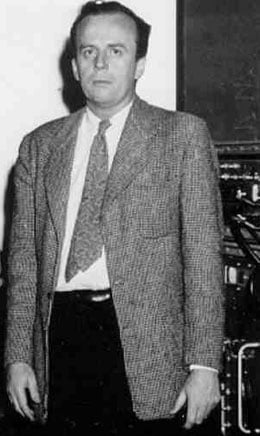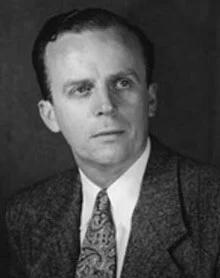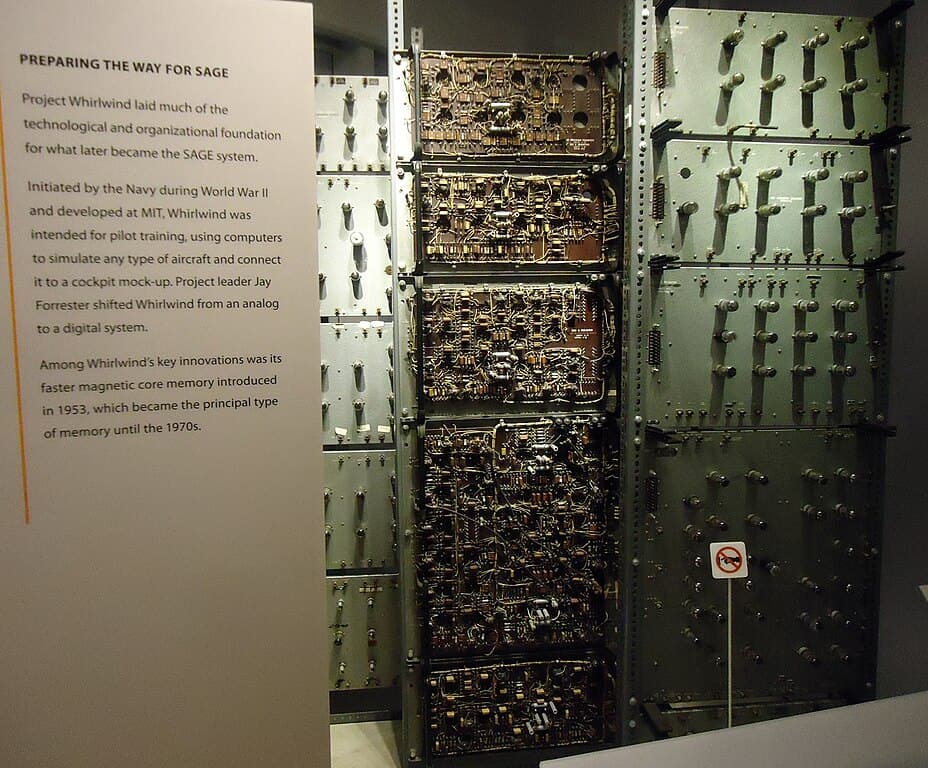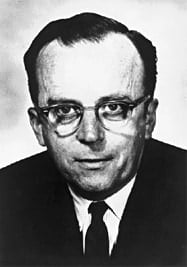
Quick Facts
- Full Name
- Joseph Licklider
- Birth
- March 11, 1915
- Death
- June 26, 1990
- Net Worth
- NA
- Awards
- Commonwealth Award for Distinguished Service
- Franklin V. Taylor
- President of Acoustical Society of America
- Children
- Tracy Robnett Licklider, Linda Licklider Smith
- Nationality
- American
- Place of Birth
- St. Louis, Missouri
- Fields of Expertise
- [“Mathematics”,”Computer Science”,”Psychology”,”Information Processing”]
- Institutions
- MIT, Harvard, ARPA, BBN
- Contributions
- “Man-Computer Symbiosis”, CTSS, Project MAC, MIT’s Lincoln Library, IPTO, foundational ideology for time-sharing computing networks
There are many claims for the “father” of internet technology. Only one has the title of computing’s “Johnny Appleseed”. This is a short biography of Joseph Carl Robnett Licklider.

Career
Shortly after graduating, J.C.R. put his Ph.D. to use. Lick worked across six influential positions in academia and computer science research until his retirement in 1985.
Director of Psycho-Acoustic Lab at Harvard
From 1943 to 1950, J.C.R. headed the Psycho-Acoustic Lab at Harvard. During his work at Harvard, he conducted field experiments in B-17 and B-24 bombers. During the war years, he was tasked to investigate how voice communication, static noise, and other sources of interference for radio receivers were affected by altitude.
The culmination of his research here led to his 1951 paper “Duplex Theory of Pitch Perception.” This paper solidified his place in the psychoacoustics field. Lick’s theories formed the foundation of modern models of pitch perception.
Associate Professor; Director of Acoustics Laboratory at MIT
He continued his influential work by moving to MIT in 1950 to become an associate professor and Director of the MIT Acoustics Laboratory. There he joined the committee that established MIT’s famous Lincoln Library. He also helped to establish a psychology program for MIT engineering students.
While in tenure at MIT, he worked heavily on Project SAGE. Project SAGE was started as a department of defense contract to build a computer-based air-defense system against long-range bombers. He served as the head of SAGE’s human-factors team. He saw this as an opportunity to put his newly forming theories about human-computer interoperation to the test.
Vice President of Bolt Beranek and Newman (BBN)
In 1957, J.C.R. left MIT to become the vice president and director of research of the departments of psychoacoustics, engineering psychology, and information systems at Bolt Beranek and Newman. It was during this time that Lick began to take a deeper look into his work process.
Lick discovered that around 85% of his ‘thinking’ time was used for clerical purposes. He referred to this as “getting into a position to think, to make a decision, to learn something needed I to know”. While most of his research on his working routine only lasted for the spring and summer of 1957, he continued to formulate his theory about how computers could help to speed up the process of research and achievement.
His new theories culminated into a seminal paper titled “Man-Computer Symbiosis”. This paper contains theories and ideas that brought forth the ideas of artificial intelligence and the relationship of computing with human needs. Many historic IT researchers still quote this paper today.
Head of Information Processing Techniques Office (IPTO) at ARPA
J.C.R.’s vision of the future of computing technology got him appointed as the Head of IPTO at ARPA, now known as DARPA, in October of 1962. Then ARPA director Jack Ruina heard Lick’s vision of interactive and symbiotic computing and hired Lick to create help create a research program in “command and control”. Lick is the one who created the IPTO program. It was so successful that it is now used as a standard for government research programs.
While in IPTO, Lick created a network of small research groups across the country. He chose researchers who shared his dream and used his access to ARPA funding to nurture their work. Among the first projects to be supported was Project MAC (Multi-Access Computer) at MIT.
He helped to fund a group number of computer researchers including:
- Stanford – AI research group lead by John McCarthy
- Berkeley – Development into time-sharing computing
- Rand Corp – Development of a “tablet” for freeform computer interface
- Carnegie Tech – Funding for a “center of excellence” in computer science to Allen Newell, Herbert Simon, and Alan Perlis
- Douglas Engelbart – who developed the mouse, hypertext, onscreen windows, and other modern graphic user interface features
With his funding and contributions to research at ARPA, J.C.R. earned the nickname of computing’s “Johnny Appleseed”. He planted the ideology and nurtured the growing ideology.
In 1963, he saw a problem with the interoperability of various researchers developments. He brought attention to this issue with a memo in April 1963 addressed to “Members and Affiliates of the Intergalactic Computer Network”. In this paper, he proposed that all of ARPA’s time-sharing computers be linked together as a national system. This would provide access to information from other developments and allow researchers to create systems that could communicate with each other. This idea is what led to the formation of ARPANet, the predecessor of the internet.
Consultant under Director of Research at IBM
After Lick’s tour of duty with ARPA, he spent two years as a consultant to the director of research at IBM. He said to have described his job with IBM as he quotes “more of a promoter than a researcher”. While he did not release any notable papers or discoveries during this time, he did spend time promoting his concept of an “intergalactic network”.
Director of Project MAC; Professor of Electrical Engineering at MIT
Lick found his way back into research and development in 1968 when he became director of Project MAC at MIT. He also maintained a professorial position in the Department of Electrical Engineering.
As a project he helped to fund, Project MAC aligned more with his interest. The project went on to produce the first computer time-sharing system known as CTSS for short. They also set up one of the first online systems with the development of Multics.
Retirement
At 70 years old, J.C.R. retired and became Professor Emeritus in 1985.
What Did Joseph Licklider Create?
Joseph Carl Robnett Licklider formulated ideology and theories around computing and informational technologies. He also helped fund the development of the systems that became modern-day computers and the infrastructure for the internet with his theories on forming a galactic network. During a time when computers required analog controls and filled an entire room, Lick was able to think into the future of what is possible and describe in detail what would be required to achieve it. He was even among the early scholars to postulate about the invention of artificial intelligence.
He is often referred to by the fathers of modern-day technology as the source of inspiration behind nearly every form of computer interaction and use. Throughout his career, he released papers that outlined a vision for the application of information technology and the logically needed steps and requirements to achieve them.
His writings are so profound that even a report about how libraries would operate in the future simply titled “The Future of Libraries” was deemed to be worthy of publication.

“Duplex Theory of Pitch Perception”
In 1951, Lick released this paper for a department of defense project. It details the theory of pitch and how it is perceived. This paper details through mathematic theory and the principles of sound the earliest known recording of the recognition of binaural audio.
This paper is what solidified J.C.R. Licklider in the psychoacoustic community as a certified professional.
Seminal Paper: Man-Computer Symbiosis
Published in 1960, this paper outlines the foundational concepts and theory behind Lick’s ideology. This work goes into detail about future uses of computers, artificial intelligence, and their relationship with mankind. It also goes into great detail breaking down the necessary hardware components to achieve his vision.
IPTO
Lick created the Information Processing Techniques Office at ARPA. The system he developed to nurture research is used as a standard outline for government-sponsored research even in the modern era.
Memo: “Members and Affiliates of the Intergalactic Computer Network”
This is the famous memo to the various small research groups spread across the country that found funding and support under the umbrella of ARPA’s IPTO. It postulated the need for universal interoperability and described early cloud storage and distributed network applications over what he called a galactic network.
He added notes on computer languages that needed to operate on higher levels, concerns about available memory and its management, and a call to develop universal standards and practices.
Joseph Licklider: Marriage, Children and Personal Life
Licklider lived a long and academically eventful life. He married Alberta Louise Carpenter. Together they were the parents of two children; their son Tracy Licklider, and their daughter Linda Licklider-Smith. They also had two grandchildren: Zachary Licklider and Allison Smith.
He passed away in 1990, the same year ARPANet was shut down.
Joseph Licklider: Awards and Achievements
Throughout his life, J.C.R. received a few awards and an honorary title.
Franklin V. Taylor Award
The Franklin V. Taylor award is given for outstanding contributions in the field of applied experimental or engineering psychology.
Honorary Title President of Acoustical Society of America
The Acoustical Society of America acts as an academic publisher for material related to the knowledge and practical application of acoustics for scientific researchers. In 1958, he was elected president due to his incredible knowledge, vision, and contributed works.
Commonwealth Award for Distinguished Service
After his death, he was awarded a medal for distinguished service for his contributions to the department of defense.
Licklider’s Published Works
Nearly all of Licklider’s writings are scientific article publications and lectures. He did have one thorough report published as a book. Here are his works:
- An Electrical Investigation of Frequency-Localization in the Auditory Cortex of the Cat, Ph.D. Thesis at University of Rochester, 1942.
- “Man-Computer Symbiosis” In “Transactions on Human Factors in Electronics”, volume HFE-1, March 1960.
- “Memorandum for Members and Affiliates of the Intergalactic Computer Network” ARPA, April 23, 1963.
- Libraries of the Future. Cambridge, Mass., MIT Press, 1965
- “Man-Computer Partnership” In “International Science and Technology”. May 1965.
- “Televistas: Looking ahead through side windows”. Report of the Carnegie Commission on Public Television, 1967.
- “Computers Are Helping Scientists Locate That Particular Pebble in the New Avalanche of Information”. 1967.
- “The Computer as a Communication Device”. In “Science and Technology”. April 1968.
Licklider Quotes
To add a fine cap to this biography, here are some notable quotes of J.C.R. Licklider:
- “The hope is that, in not too many years, human brains and computing machines will be coupled together very tightly, and that the resulting partnership will think as no human brain has ever thought and process data in a way not approached by the information-handling machines we know today.”
- “We need to substitute for the book a device that will make it easy to transmit information without transporting material.”
- “Men are noisy, narrow-band devices, but their nervous systems have very many parallel and simultaneously active channels. Relative to men, computing machines are very fast and very accurate, but they are constrained to perform only one or a few elementary operations at a time. Men are flexible, capable of ‘programming themselves contingently’ on the basis of newly received information. Computing machines are single-minded, constrained by their ‘pre-programming’.”
Up Next…
Interested in finding out about other influential individuals who changed our world forever? Read the following articles below:
- Charles Goldfarb: This Harvard-trained lawyer was responsible for developing the first markup language which would influence the development of HTML. Find out how he did it, here.
- Leonard Kleinrock: Along with Donald Davies and Paul Baran he was responsible for creating packet-switched networks and indirectly ensuring the creation of the Web. Here is how he did just that.
- Donald Davies: This Distinguished Fellow of the British Computer Society is credited with creating packet-switched networks, alongside Paul Baran and Leonard Kleinrock. Read all about him here.
The image featured at the top of this post is ©Public domain, via Wikimedia Commons.
